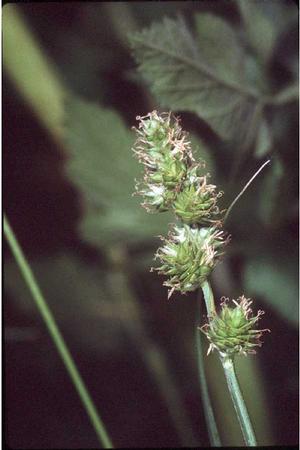
That’s right folks we had Diarrahena.
Get your minds out of the bathroom, or off the cruise ship, honestly people – has this weather driven you mad?
Diarrhena americana otherwise known as American beakgrain, is a native grass found in moist woods in part to full shade. Sounds like a challenging location that is difficult to find plants that will succeed. It is easy to grow and even has a yellow fall color and turns a nice brown through winter. But we couldn’t sell it. It is not especially ornamental, some may call it weedy, but it’s name certainly did not help matters much. I mean its name is Diarrhena.
It is too late for Diarrhena, at least here at New Moon Nursery But we currently have some other plants that may not be on the top of your plant list simply because their scientific name is a little less than attractive, but rest assured, despite their name they are attractive and will be a beautiful addition to your projects. This may be the one case we recommend using the common names in discussion with your clients.
Antennaria neglecta – The field pussytoes. The word neglect doesn’t exactly conjure up visions of a great landscape plant. Well okay, maybe this one has no great name option. Maybe think of this name reminding you that even if you neglect the plant it will still do terrifically. But it is certainly worth consideration in your next project, especially if the site is dry, rocky, a disturbed site with sun and well-drained soils. Not only does this plant boast mat-forming silvery-gray felt-like leaves (that’s a lot of compound modifiers) it also boasts dense white flower heads in spring – similar to a kitten’s paw – that’s where the name comes from. They stay small rarely getting beyond 1 square foot and a foot tall. They are generally deer and pest resistant, though one insect finds Antennaria neglecta irresistible. Field pussytoes is the host plants for the American Painted Lady butterfly caterpillar.

American Painted Lady Caterpillar on Field Pussytoes
Carex blanda – as if it is not already difficult enough to sell sedges to the masses. Folks not in the know about the wonders of the diversity in form, color and culture of sedges would likely not be drawn to a sedge with the word bland in its name. But the Common Wood Sedge (I mean can we get some marketing people on the plant naming committees please…) is a compact clump forming perennial that will do well in part to full shade and moist to mesic soils. The shiny foliage gets up to 8″ long and is a wonderful option for a shade loving ground cover. If you know folks who adore Liriope and Ophiopogon but are looking for a native alternative, this may be the plant for them, not bland at all.
Carex molesta , the field oval sedge also known as the troublesome sedge, is also woefully lacking in the desirable names department. There are two possibilities for this name (molesta meaning troublesome): the first referring to the readiness of this sedge to flourish in sunny wet sites, seeding in with abandon; the other referring to the difficulty of distinguishing this sedge from others in the group to which this sedge belongs. This plant does have a place in your sunny, wet landscapes and will even tolerate drought once established. Deer do not seem to prefer it and other pests tend to stay away as well.
You may be tempted to prefer Carex elata or Carex socialis instead, thinking they may be more fun in the landscape, more well-behaved, better to have mixed in with your other plants and this may be true, but that does not mean the others with the less-than-life-of-the-party names wouldn’t be great in the gardens also.

Carex molesta, Troublesome Sedge
Liatris scariosa the Savanna Blazing Star is anything but scary. Do not be intimidated by the 5′ stature of this clumping perennial. Do not fret about the swarms of pollinators and beneficial insects that will visit. The plant’s other common name of Devil’s Bite is nothing to be worried about. Concentrate on the bright purple summer flowers, the plant’s deer, drought, heat and poor soil tolerance rather than the chilling scientific name.

Blephilia ciliata the Downy Wood Mint, well first has the word mint in it which is enough to turn people off immediately, but also Blephilia – the name starts with the word Bleh… as in boring, meh, ho-hum. But it is important to know – VERY IMPORTANT TO KNOW – this plant is less aggressive than many other mints, more clump forming than some others that have put folks off mints forever. The lavender blooms resemble those of bee balm and attract as many pollinators. Despite being called a wood mint, this plant thrives in open sunny areas far better than in woodland settings.
and finally
Eupatorium dubium. AKA Eutrochium dubium One definition of dubious is “not to be relied upon”, but trust us, you can rely on the Three-nerve Joe Pye. This is a compact version of the taller Eupatorium purpureum. Pink flower clusters top purple spotted stout stems and are frequently covered with butterflies in its sunny moist sites. The unbranched stems can get up to 5′ tall and are pest resistant.


So here are a few plants in much need of a name make-over. Something more catchy, something less offensive, something less reminiscent of discomfort. Like Archibald Alec Leach becoming Carey Grant or Marion Robert Morrison becoming John Wayne, these plants just need you to have some faith in their performance and potential.
How about you – any plants you can think of that need a marketing/PR make over?





[…] we plant some and not others, why “nativars” are a thing and why New Moon Nursery can’t sell ugly plants (we have tried! and tried again!)- because we plant them (and are able to sell them to our […]
[…] the past we have had some fun with our plants’ names and we have expressed our frustration with seemingly constantly changing plant names but we also […]